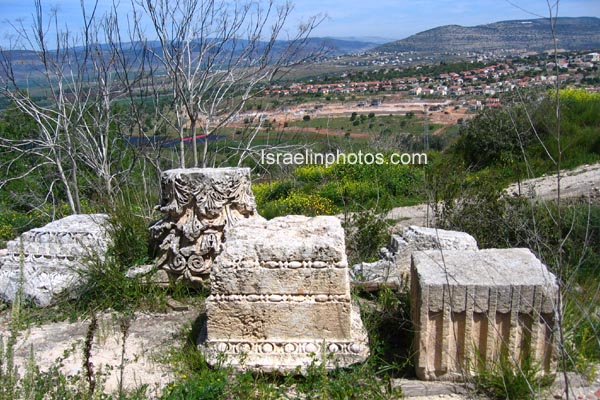According to the Babylonian Talmud (Megillah 6) Zippori got its name because it sits on a mountaintop like a bird (zippor). Rising only 115m above the fertile Bet Netofa Valley to the North, the numerous springs in the area and its central strategic location, it permits a bird's eye view over the surrounding countryside.
Ancient Zippori is first mentioned in Josephus Flavius' description of the reign of the Hasmonean king Alexander Jannaeus. A few decades later, Zippori had become the most important city in the Galilee. In 38 BC, Herod took Zippori without a battle during a rare snowstorm, and stockpiled weapons there. After Herod's death in 4 C.E., the citizens began to mutiny (known as the Varus War); eventually the soldiers under Roman governor Varus captured Zippori. "He took the city of Sepphoris and burnt it and made slaves of its inhabitants" (War 2:68). Some historians maintain that the residents of Zippori learned their lesson from this experience, which is why they later refused to take sides in the Jewish War against the Romans.
Herod Antipas, who inherited Galilee from his father, thus found this capital a deserted ruin. He did such a fine job of restoring and beautifying the city, that Josephus named it the "glory of the entire Galilee". The project probably drew the artisan Joseph and his family to settle in nearby NAZARETH (Matt.2:21-3); it would provide work for many years. When the renowned Rabbi Judah Hanasi moved to Zippori from Bet She'an, he brought with him the Sanhedrin (assembly of 71 ordained scholars, which served both as legislature and as Supreme Court). Rabbi Judah Hanasi put the final touch on the Mishna in Zippori (220 CE). The scholars living in Zippori also participated in writing the Jerusalem Talmud, completed in the fourth century.
Like all residents of the Galilee, during the fourth century the people of Zippori suffered greatly under Roman rule. In the year 351, the Jews revolted against Gallus Caesar: They attacked the local garrison, killed the soldiers, and took their arms. This rebellion was firmly quashed. Christian sources tell that Zippori was razed to the ground in the revolt, but there is no archeological evidence to support this. Archeologists did find, however, that the city was destroyed in 363 in an earthquake.
From the fifth century on, both Christians and Jews inhabited Zippori. During the Middle Ages, Zippori still had a small Jewish community, as evidenced by a letter written in the tenth century and discovered in the Cairo Genizah (Jewish archive). Its location at an important crossroads on the pilgrimage route from Acre (Akko) to Nazareth led to the erection of a Crusader fort, but the town appears to have been of no real significance. The Crusaders built a church in memory of St. Anne at Zippori. They believed that Mary's parents, St. Anne and St. Joachim, had lived in Zippori. It was from the spring south of Sepphoris that the Crusader army set out on the 3rd of July 1187 for the relief of Tiberias and was defeated the next day at the Horns of Hittin. Taken by Saladin that summer, it was restored to the Crusaders by treaty in 1240 and was held by the Templars until captured by the Mamluk sultan Baybars in 1263. Parts of the Crusader church are still standing.
Sites of interest at the Zippori National Park include the 4,500-seat Roman theater, built on the slope overlooking the Bet Netofa Valley and the Upper Galilee mountains (some of the seats have been reconstructed); the living quarter from the Mishnaic and Talmudic periods; the Crusader fortress on top of the hill, visible from a great distance; the villa built in the early third century with illustrations from the life of Dionysus, the Greek god of wine (the stunning mosaic in this building is known as the Mona Lisa of the Galilee); the Roman-period lower city with its carefully laid-out series of parallel and perpendicular streets; the Nile Mosaic building, a large fifth century structure with an ornate mosaic floor depicting the festival held when the level of the Nile River reached its highest point; a complete synagoge dated to the early 5th century CE. The synagogue has a richly colored mosaic floor depicting an abundance of Jewish symbols, biblical scenes and dedicatory inscriptions in Aramic and Greek. The giant underground waterworks, built in the first century and in operation until the seventh. The 250 meter-long reservoir, which could hold 5000 cubic meters of water, is about a kilometer and a half away.


















